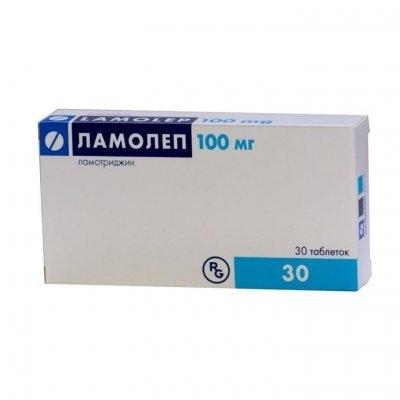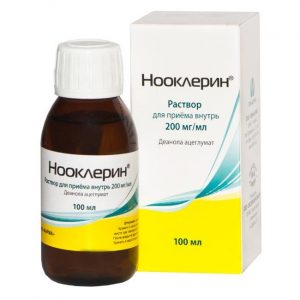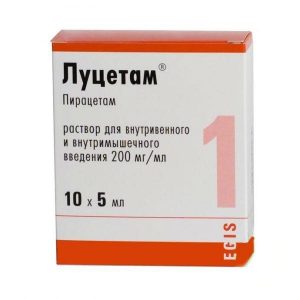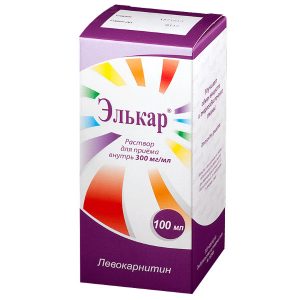Description
Release form
Tablets are white or almost white, biconvex, with L100 engraving on one side.
Packing
10 pcs. – blisters (3) – packs of cardboard.
Pharmacological action
Antiepileptic drug. Stabilizes the voltage-dependent sodium channels of cell membranes. It blocks the release of neurotransmitters, mainly glutamine amino acid (which plays a key role in the development of epileptic seizures).
Pharmacokinetics
Absorption
After oral administration, it is rapidly and completely absorbed from the intestine and is not significantly affected by the first passage. Cmax is reached 2.5 hours after ingestion. Eating slows down the absorption process, but does not affect its effectiveness. Bioavailability is 98%. The pharmacokinetics of the drug after a single dose in a dose not exceeding 450 mg is linear. Concentration in an equilibrium state has a pronounced individual character.
Distribution of
Protein binding is 55%. It is unlikely that squeezing lamotrigine out of association with proteins can cause a toxic effect. Vd is 0.92-1.22 l / kg body weight. Excreted in breast milk. Concentration in breast milk is 40-60% of the plasma concentration. In some cases, the concentration of the drug in the blood serum of infants whose mothers took the drug during lactation reaches a therapeutic level.
Metabolism
Biotransformed in the liver under the influence of uridine diphosphate glucuronyl transferase. Among the metabolites, N-glucuronides predominate. Lamotrigine moderately and dose-dependently induces its own metabolism.
Excretion of
The average equilibrium clearance in healthy adults is 39 ± 14 ml / min. It is excreted together with urine in the form of a glucuronide conjugate, less than 10% – unchanged, about 2% (unchanged and metabolites) – with feces. The clearance and T1 / 2 are dose-independent. T1 / 2 of healthy volunteers is 24-35 hours.
Pharmacokinetics in special clinical cases
The clearance, calculated per kg of body weight, is higher in children than in adults and is highest up to 5- summer age. T1 / 2 in children is usually shorter than in adults.
T1 / 2 in children with simultaneous use with enzyme inducers is 7 hours, with sodium valproate – 45-60 hours.
Lamotrigine clearance in the elderly and younger patients is minimally different from each other.
Indications
Epilepsy
for adults and children over 12 years of age
as monotherapy or in combination with other antiepileptic drugs for the treatment of partial and generalized seizures (incl. tonic-clonic seizures and seizures in Lennox-Gastaut syndrome)
for children from 2 to 12 years of age
as part of combination therapy for the treatment of partial and generalized seizures (including tonic-clonic seizures and seizures in Lennox-Gastaut syndrome )
Bipolar disorder
for adults (18 years of age and older)
for the prevention and treatment of mainly episodes of depression.
Contraindications
children under 2 years of age
pregnancy
lactation (breastfeeding)
hypersensitivity to lamotrigine or any component of the drug.
Caution is advised to administer the drug to patients with renal failure (due to the possible cumulation of glucuronide metabolite).
Use caution in prescribing the drug to children as the drug of choice for monotherapy of epilepsy.
Use in case of impaired liver function
For impaired liver function of moderate degree (class B on the Child-Pugh scale), the initial, increasing and maintenance doses should be reduced by approximately 50%, in severe cases (class C on the Child-Pugh scale) – by 75 % Increasing and maintenance doses should be adjusted according to the clinical effect.
Use in cases of impaired renal function
Caution should be exercised when administering the drug to patients with renal failure.
Use in children
With caution, prescribe the drug to children as the drug of choice for monotherapy of epilepsy. Contraindication: children under 2 years old.
Use in elderly patients
Correction of the dosage regimen in elderly patients (over 65 years) is not required (since the pharmacokinetics in this age group are not different from those in adults).
Use during pregnancy and lactation
Lameolep is contraindicated in pregnancy, unless the expected therapeutic benefit to the mother outweighs the potential risk to the fetus. Due to the inhibitory effect of lamotrigine on dihydrofolate reductase, the development of fetal malformations during the use of the drug during pregnancy is likely, however, currently available data are insufficient to determine the degree of safety.
Data on the use of the drug during breastfeeding is limited. In some cases, the concentration of the drug in the blood serum of infants, whose mothers took the drug during lactation reaches a therapeutic level. When using the drug during lactation, the benefits of breastfeeding and the likelihood of side effects in the child should be carefully weighed.
Special instructions
There is no evidence to support the clinically significant inducing and inhibitory effects of lamotrigine on oxidative enzymes in the liver. The ability of the drug to induce its own metabolism is small and probably does not have clinical significance.
Lameolef should not be prescribed concurrently with other drugs containing lamotrigine.
If Lameolep provides good control of epilepsy attacks, you can stop taking other antiepileptic drugs.
An objective criterion for the effectiveness of treatment is the ability to reduce the frequency of peaks on the EEG by 78-98%.
In the first 8 weeks of treatment, skin reactions may develop. Skin rashes are usually mild and disappear spontaneously. Perhaps the development of severe forms requiring hospitalization and discontinuation of lamotrigine therapy (for example, Stevens-Johnson syndrome and toxic epidermal necrolysis). The use of the drug in high initial doses and the acceleration of the recommended rate of increase in the dose of lamotrigine, as well as the simultaneous administration of valproic acid preparations contribute to the appearance of a skin rash. To reduce the likelihood of developing such dermatological reactions, the indicated doses and the rate of their increase should be strictly observed.
Children are more prone to developing severe skin reactions (incidence, children requiring hospitalization is 1 / 300 ² 1 / 100).
The early symptoms of an allergic rash are easily confused with an infectious rash, so if a fever and rash occur in the first 8 weeks of treatment, a drug reaction should be suggested.
It is important to remember that early manifestations of hypersensitivity reactions (eg, fever, lymphadenopathy) can occur without a rash. If a rash appears (regardless of the patient’s age), a thorough examination of the patient should be immediately carried out and therapy with lamotrigine should be discontinued if the development of dermatological symptoms cannot be explained by another reason.
The appearance of a rash can be accompanied by various systemic manifestations of hypersensitivity (high body temperature, lymphadenopathy, facial swelling, reactions from the liver and hematopoietic system). The severity of hypersensitivity reactions can be different, sometimes it is possible to develop disseminated intravascular coagulopathy and multiple organ failure. It should be borne in mind that early signs of hypersensitivity (for example, high body temperature, lymphadenopathy) are not always accompanied by a skin rash.
Impaired liver function is usually part of hypersensitivity syndrome, but is not always accompanied by other symptoms.
Long-term treatment with lamotrigine may alter folic acid metabolism, as lamotrigine is a weak dihydrofolate reductase inhibitor. At the same time, a long, 12-month treatment with lamotrigine does not significantly affect the level of hemoglobin, the average volume of red blood cells, the concentration of folic acid in plasma and red blood cells, and after 5 years of treatment, the concentration of folic acid.
In case of lactose intolerance, it should be borne in mind that the composition of tablets containing 25 mg of lamotrigine includes 16.35 mg of lactose monohydrate containing 50 mg – 32.5 mg, 100 mg – 65 mg.
Despite the fact that when taking oral contraceptives, lamotrigine does not affect the concentration of ethinyl estradiol and levonorgestrel, irregular menstruation during lamotrigine therapy in patients taking oral contraceptives requires close attention of the attending physician.
When treating patients with renal failure undergoing hemodialysis, it should be borne in mind that on average 20% of lamotrigine is excreted from the body during 4-hour hemodialysis.
Abrupt cessation of lamotrigine treatment provokes epileptic seizures, up to status epilepticus. Therefore, with the exception of special cases (for example, the appearance of a skin rash) requiring immediate discontinuation of therapy, drug withdrawal is carried out gradually with a smooth, 2-week, dose reduction.
Severe convulsions and epileptic status can lead to the development of rhabdomyolysis, multiple organ failure, and disseminated intravascular coagulopathy, sometimes fatal. Similar cases have occurred in connection with the use of lamotrigine.
For bipolar disorders, suicidal tendency is characteristic, therefore, when prescribing the drug to patients with a suicidal tendency, careful monitoring of patients is required.
Influence on the ability to drive vehicles and operate machinery
During treatment, it is forbidden to drive a car and engage in activities that require an increased concentration of attention and speed of psychomotor reactions.
Composition
1 tab.
lamotrigine 100 mg
Excipients:
silicon dioxide colloidal anhydrous,
magnesium stearate,
povidone,
sodium carboxymethyl starch,
lactose monohydrate,
cellulose microc.
Side effects
Adverse reactions are presented for each indication separately, using the following conditional classification of the frequency of adverse reactions: very often (> 1/10), often (> 1 / 100.1 / 1000, <1/100), rarely ( > 1/10 000,
In patients with
epilepsy From the hematopoietic system: very rarely – neutropenia, leukopenia, anemia, thrombocytopenia, pancytopenia, aplastic anemia, agranulocytosis.
Allergic reactions: very often – in the first 8 weeks of treatment, skin rash maculopapular) which rarely disappears after lamotrigine withdrawal – Stevens-Johnson syndrome, very rarely – hypersensitivity syndrome (including symptoms such as fever, lymphadenopathy, swelling of the face, disorders of the blood and liver functions, DIC, multi-organ disorders), toxic epidermal necrolysis (syndrome Lyella, in some cases, recovery with scarring).
From the side of the central nervous system: very often – headache often – irritability, drowsiness, insomnia, dizziness, tremor, nystagmus, ataxia, anxiety sometimes – aggressiveness very rarely – increased irritability, hallucinations, confusion, imbalance, worsening of Parkinson’s disease, extrapyramidal disorders, choreoathetosis, increased frequency of convulsive seizures.
From the side of the organ of vision: very often – diplopia, blurred vision rarely – conjunctivitis.
From the digestive system: often – nausea, vomiting very rarely – increased levels of liver enzymes, impaired liver function, liver failure.
Other: often – increased fatigue very rarely – lupus-like syndrome.
In patients with bipolar disorder
In addition to the symptoms listed above, the following phenomena are also possible.
From the musculoskeletal system: often – arthralgia, myalgia, back pain.
Drug interaction
With simultaneous use, valproic acid preparations competitively block liver enzymes and inhibit lamotrigine metabolism, almost double its average T1 / 2, lengthening it to 70 hours.
Antiepileptic drugs-inducers of liver enzymes (such as phenazenbenzo carbenazen and primidone), as well as paracetamol stimulate the metabolism of lamotrigine and reduce its T1 / 2 by 2 times, up to 14 hours (phenytoin, carbamazepine). In patients taking carbamazepine, the introduction of lamotrigine can cause unwanted effects from the central nervous system, including dizziness, ataxia, diplopia, decreased visual acuity and nausea. Reducing the dose of carbamazepine usually leads to the disappearance of these phenomena.
With simultaneous use, lamotrigine does not affect the concentration of other antiepileptic drugs in plasma, as well as the concentration of ethinyl estradiol and levonorgestrel (which are part of the simultaneously used oral contraceptives).
With the simultaneous use of lamotrigine does not reduce the clearance of drugs in the metabolism of which CYP2D6 is involved.
With the simultaneous use of clozapine, phenelzine, risperidone, sertaline and trazodone, apparently do not affect the clearance of lamotrigine.
There is no data on the effect of lamotrigine on the pharmacokinetics of other antiepileptic drugs and on the drug interaction between it and drugs metabolized with the participation of isoenzymes of the cytochrome P450 system.
Perhaps combined with sedatives, antiepileptic and anxiolytic agents.
Overdose
Symptoms: nystagmus, ataxia, headache, vomiting, drowsiness, impaired consciousness up to coma.
Treatment: hospitalization in hospital and appropriate supportive and symptomatic therapy if necessary, gastric lavage and activated charcoal.
Storage conditions
The product should be stored in the original package in a place out of the reach of children at 15 ° to 30 ° C.
Shelf life
2 years
Terms and conditions
prescription
dosage form
tablets
Possible product names
LAMOLEP 0.1 N30 TABLE
Lameolep 100mg Tab. X30
Lameole tab. 100mg x 30
LAMOLEP TAB. 100MG No. 30
LAMOLEP TAB. 100MG No. 30 (12.12)




